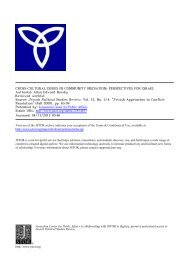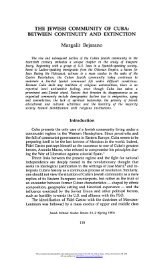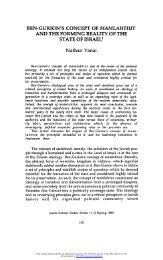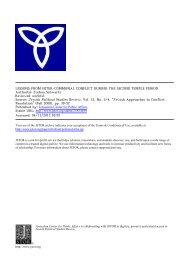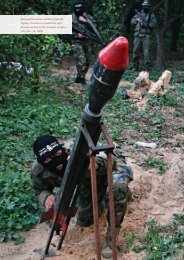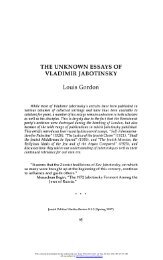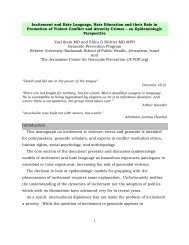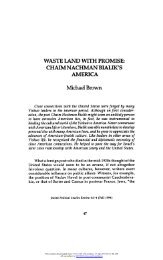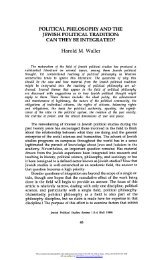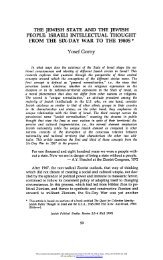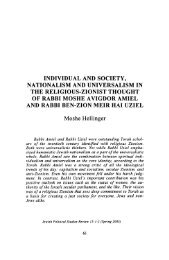Linking the Gaza Strip with the West Bank: - Jerusalem Center For ...
Linking the Gaza Strip with the West Bank: - Jerusalem Center For ...
Linking the Gaza Strip with the West Bank: - Jerusalem Center For ...
Create successful ePaper yourself
Turn your PDF publications into a flip-book with our unique Google optimized e-Paper software.
page 52wander until it is time to return.” Thus, it appears thateven in <strong>the</strong> hostile Middle East, non-contiguous states,such as Israel for <strong>the</strong> first two decades of its existence,can be viable.Some states remain discontiguous to <strong>the</strong>present. Examples of current non-contiguousstates that are none<strong>the</strong>less viable include:• Angola is separated from its oil-rich, 158 mile-longCabinda Province by <strong>the</strong> Democratic Republic of <strong>the</strong>Congo. 293• Russia maintains <strong>the</strong> Oblast of Kaliningrad, which isa non-contiguous enclave surrounded by Lithuania,Poland, and <strong>the</strong> Baltic Sea. 294• Azerbaijan includes <strong>the</strong> exclave of <strong>the</strong> NaxcivanAutonomous Republic, which is separated fromAzerbaijan-proper by Armenia (an unresolved disputeexists between Azerbaijan and Armenia over <strong>the</strong>Nagorno-Karabakh region). 295• Brunei consists of two territories, physically separatedby Malesia. 296• East Timor is separated from its Oecussi (Ambeno)region on <strong>the</strong> northwest portion of <strong>the</strong> island of Timorby Indonesia. 297• Oman controls <strong>the</strong> strategic port of MusandamPeninsula, although it is separated by territorybelonging to <strong>the</strong> United Arab Emirates. 298• Argentina is separated from its sou<strong>the</strong>rn region ofUshuaia by Chilean territory. 299• The United States is separated from its state of Alaskaby approximately 500 miles of Canadian territory. 300• The sou<strong>the</strong>rn region of Croatia is separated from <strong>the</strong>rest of Croatia by a 16-mile stretch of Bosnian coast.The fact that <strong>the</strong>re were and are non-contiguous states,which are viable, appears to militate against <strong>the</strong> callfor a territorially contiguous Palestinian State as aprerequisite for its viability. The state, it appears, couldfunction and maintain a separate existence <strong>with</strong>out suchcontiguity.ConclusionConventional wisdom insists that a territorial link between<strong>Gaza</strong> and <strong>the</strong> <strong>West</strong> <strong>Bank</strong> -- whe<strong>the</strong>r sovereign or not -- isessential for <strong>the</strong> existence of a viable Palestinian State.Thus, safe passage is called for to link <strong>Gaza</strong> and <strong>the</strong> <strong>West</strong><strong>Bank</strong>. Indeed, <strong>the</strong> need for a territorial link of some sortis often imbedded in <strong>the</strong> call for a viable PalestinianState, <strong>the</strong> premise being that a non-contiguous statecannot be viable. This monograph’s analysis revealsthat <strong>the</strong> lack of a link between separated territories doesnot affect whe<strong>the</strong>r a new political community should berecognized as a state under international law. In addition,based on past and present international practice, a statedoes not possess an inherent right to a link between itsgeographically distinct areas. In particular this may beapplied to <strong>the</strong> sovereign link called for by <strong>the</strong> Palestiniansbetween <strong>Gaza</strong> and <strong>the</strong> <strong>West</strong> <strong>Bank</strong>.Not<strong>with</strong>standing conventional wisdom, <strong>the</strong> need for sucha link is questionable. One generally thinks that at <strong>the</strong>very least <strong>the</strong> Palestinians need to be able to transportgoods between <strong>the</strong> <strong>Gaza</strong> <strong>Strip</strong> and <strong>West</strong> <strong>Bank</strong> for <strong>the</strong>irstate to be viable. However, this is not <strong>the</strong> case. First,<strong>the</strong>re were convoys, discussed above, which affect <strong>the</strong>movement of goods from <strong>Gaza</strong> to <strong>the</strong> <strong>West</strong> <strong>Bank</strong>, andfrom <strong>the</strong>re to Jordan. Interestingly, this was in usefor ten years, despite <strong>the</strong> absence of any safe passageregime. Second, being a member of <strong>the</strong> Arab League ofStates and a signatory to <strong>the</strong> Arab Transit Agreement of1977, ‘Palestine’ has <strong>the</strong> right of free transit across <strong>the</strong>territories of all Arab countries that are parties to <strong>the</strong>Agreement. Both Egypt and Jordan are signatories to<strong>the</strong> Agreement. They are <strong>the</strong>refore under an obligation toexempt Palestinian goods in transit from customs duties,taxes and o<strong>the</strong>r such charges. 301 This would surelybe preferable to a safe passage <strong>with</strong> its many securitychecks, customs and duties. This has not been fullycapitalized upon, and while “<strong>the</strong> right of <strong>the</strong> Palestinians<strong>with</strong> regard to transit transport is practiced” it is done ona “very exceptional basis.” 302 There is no reason for thisnot to be capitalized upon in as much as <strong>the</strong> Arab statesprofess <strong>the</strong>ir commitment to an economically successfulPalestinian State. Thus, <strong>the</strong> need for safe passage isquestionable.



